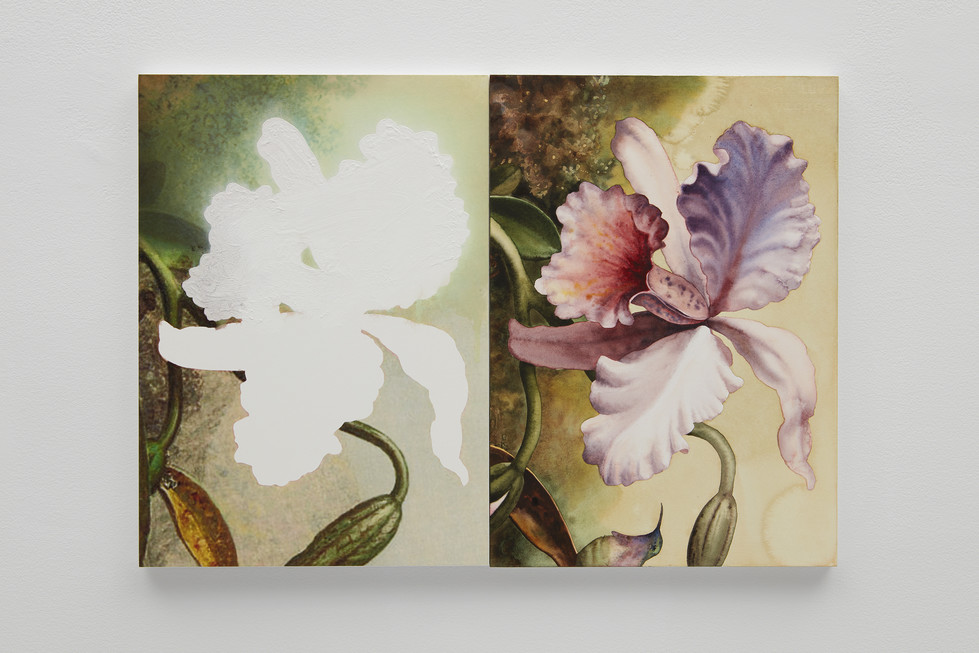
2019 MARC HANDLEMAN
When Marc Handelman was a teenager, his family took him on two historical pilgrimages—one to the Nazi concentration camp at Dachau and another to Hiroshima to see where the Americans had dropped The Bomb. As a biracial Japanese-Jewish-American, he felt the historical implications of the horrors reflected in branches of his identity from opposite sides of the world and opposite sides of the war. As an adult, Handelman gravitated towards theoretical discourses and artistic practices that problematized notions of belonging and identity, at least partly as an attempt to find a language that could express the complex confluence of unreconcilable cultural and historical currents he’d long felt within himself. One writer who had a profound effect on him, and to whom his present series of paintings is dedicated, is the Caribbean poet and philosopher Édouard Glissant, for whom all identities are inherently unstable and always in the process of being transformed, sometimes violently, through their exchanges with other unstable and ever-shifting identities.
Towards a Form of Voluntary Dispossession (for Édouard Glissant) takes as its ostensible subject the Caribbean orchid paintings of nineteenth-century Luminist painter Martin Johnson Heade. Through his own research, Handelman came to realize that these paintings — which Heade purported to be naturalistic depictions of various strains of an orchid species in their respective “natural” settings from Jamaica to Colombia — were, in fact, the selfsame orchid with identically-shaped petals, posed at the same three-quarter’s angle. As it turns out, Heade had originally sketched a single orchid specimen during a single visit to a botanical garden in New England, then simply inserted that orchid, cookie-cutter style, onto different backgrounds. Sometimes Heade rotated the orchid or gave it a different color, but its form and shape was always exactly the same.
For Handelman, Heade’s deception—passing off replicant images as unique ones and artifice as naturalism—is illustrative of a larger problem. It’s both a metaphor and an embodiment of the way that pernicious ideologies, such as colonialism, cloak their inherent violence beneath a façade of naturalism. In his Towards a Form of Voluntary Dispossession series, Handelman uses digital reproduction and repetition to uncloak Heade’s deception, revealing the thoroughly unnatural, constructed nature of his paintings for what they are. At the same time, by going back into Heade’s orchids and gorgeously reworking each of them by hand—using an impressive range of watercolor techniques from stain painting to Photorealism—Handelman has been able to give back to the orchids some of the opacity, strangeness, and ineffable beauty that Heade’s oppressive standardization had robbed them of in the first place. Handelman’s orchids are no more “natural” than Heade’s, of course, but by making their own unnaturalness obvious, rather than concealing it, the new representations become self-aware. In subtly subversive and playful ways, they resist the false transparency of representation. And Handelman encourages their rebellion, using process-based techniques to “voluntarily dispossess” himself of full authorial control over the orchids, even as he paints (and repaints) them lovingly.
Handelman’s orchids are children of history whose identities have been shaped by the violence of colonialist representation. There is no way to return them to the imagined innocence of a “pre-contact” state or let them simply be “flowers for flowers’ sake,” as if floating in a timeless Garden of Eden. What Handelman can and does do, however, is to let Heade’s flowers move in new visual and material directions, drifting away from standardization toward unexpected aesthetic forms. Whereas Heade had presented his orchids within the artifice of a naturalistic narrative that imputed to them a simple one-to-one relationship to their territorial settings, Handelman’s reconstituted orchids possess wonderfully rich, multilayered identities that cannot be easily named or defined. In their multiplicity, and forms of hybridity, we might even see them as self-portraits of the artist. Or perhaps, in the words of Gertrude Stein, they become “everybody’s self-portrait,” if each of us is only temporarily and provisionally constituted within a sea of ever-changing identities. Like nature itself, we are always morphing and evolving but never fully at home within ourselves.